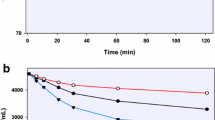Abstract
We conducted in vivo and in vitro studies of the reductive metabolism of the cholagogue, dehydrocholic acid (DHCA). Immediately after the intravenous administration of 1 g of DHCA in normal subjects (n=6), the concentration of the reductive metabolite, 3α-hydroxy-7,12-dioxo-cholanoic acid (unconjugated form), increased sharply in the systemic conjugated form), increased sharply in the systemic circulation, rising to 95.8 μM 10 min after administration. The results of in vitro experiments with DHCA and whole blood showed that 3α-hydroxy-7,12-dioxo-cholanoic acid and 3β-hydroxy-7,12-dioxo-cholanoic acid were produced from DHCA. In vitro experiments using DHCA and the red blood cell fraction, and DHCA and the red blood cell cytoplasmic fraction gave similar results to those described above with whole blood. However, a reductive metabolite was not formed by the incubation of DHCA and the red blood cell membrane fraction. These findings indicated that, contrary to the conventional theory that intravenously administered DHCA is subjected to reductive metabolism only in the liver, reduction also occurs in the systemic circulation, and the mechanism for this reductive metabolism is present in the cytoplasmic fraction of red blood cells. Further investigation to characterize this reductive metabolic system revealed an optimum temperature of 37°C, an optimum pH of 7.4, a Km value of 2.0×10−3M, and inactivation by heart treatment (70°C for 2 min).
Similar content being viewed by others
References
Matsumoto H, Tomita H. Clinical applications and mechanism of intravenous taste test. Auris Nasus Larynx (Tokyo) 1990; 13(Suppl):43–50.
Garry J, Robert H. Sodium dehydrocholate circulation times in digital subtraction angiography. Am J Radiol 1983;140:817–818.
Ogura M, Wakutani T, Yamashita K. The fate of14C-dehydrocholate administered to bile fisula rabbits. Yonago Acta Medica 1960;4(3):179–188.
Ogura M, Yamasaki K. The fate of14C-labeled dehydrocholic acid in guinea pig. J Biochem 1961;49:649–659.
Soloway RD, Hofmann AF, Thomas PJ, et al. Triketocholanoic (dehydrocholic) acid. Hepatic metabolism and effect of bile flow and biliary lipid secretion in man. J Clin Invest 1973; 52:715–724.
Yoneda M, Makino I, Tamasawa N, et al. The biotransformed metabolite profiles in blood after intravenous administration of dehydrocholic acids. Am J Gastroenterol 1990;84(3):290–295.
Mashige T, Imai K, Osuga T. A simple and sensitive assay of total serum bile acids. Clin Chim Acta 1976;70:79–86.
Yoneda M, Tamasawa N, Makino I, et al. Development of enzymatic determination of 3-keto bile acids in serum. Jpn J Gastroenterol 1990;84(3):290–295.
Goto J, Miura H, Inada M, et al. Determination of bile acids in liver tissue by gas chromatography-mass spectrometry with negative ion chemical ionization detection. J Chromatogr 1988;452:119–129.
English D, Anderson BR. Single-step separation of red blood cells and granulocytes on discontinuous density gradients of Ficoll-Hypaque. J Immunol Methods 1974;5:249–252.
Dodge JT, Mitchell CD, Hanahan J. The preparation and chemical characteristics of hemoglobin-free ghosts of human erythrocytes. Arch Biochem Biophys 1963;100:119–130.
Nakagawa S, Imuro S, Suzuki S. Gallensäurebelasprobe zur Leberfunktionsprüfung. Klin Wochenschr 1934;13:1392–1394.
Kallner A. On the reduction of 3-keto bile acids in vitro. Arkiv för Kemi 1967;26:553–565.
Berseus O. Conversion of cholesterol to bile acids in rat, purification and properties of Δ4-3-ketosteroid-5β-reducatse and a 3α-hydroxysteroid dehydrogenase. Eur J Biochem 1967; 2:493–502.
Amuro Y, Yamada W, Nakano T, et al. Reduction of 7-ketolithocholic acid to chenodeoxycholic acid by rat liver preparations in vitro. Biochim Biophys Acta 1985;841:229–231.
Amuro Y, Yamada W, Yamamoto T, et al. Pathal purification and characterization of 7α-hydroxysteroid dehydrogenase from rat liver microsome. Biochim Biophys Acta 1987;917:101–107.
Kikuchi H. The metabolic sequence for the occurrence of an anomalous bile acid, 12-ketochenodeoxycholic acid, found in the bile of hepatobiliary diseased patients. J Biochem 1972; 72:165–172.
Stolz A, Takikawa H, Sugiyama Y, et al. 3α-Hydroxysteroid dehydrogenase activity of the Y' bile acid binders in rat liver cytosol. Identification, kinetics, and physiological significance. J Clin Invest 1987;79:427–434.
Takikawa H, Fujiyoshi M, Nishikawa K, et al. Purification of 3α-hydroxysteroid and 3β-hydroxysteroid dehydrogenase as keto bile acid reductase from human liver cytosol. Hepatology 1992;16:365–371.
Kudo K, Amuro Y, Hada T, et al. Purification and properties of 3α-hydroxysteroid dehydrogenase as a 3-keto bile acid reductase from human liver cytosol. Biochim Biophys Acta 1990;1046:12–18.
Stolz A, Rahimi-Kiani M, Ameis D, et al. Molecular structure of rat hepatic 3α-hydroxysteroid dehydrogenase. J Biol Chem 1991;266:15253–15257.
Penning TM, Talalay P. Inhibition of a major NAD (P)-linked oxidoreductase from rat liver cytosol by steroidal, nonsteroidal anti-inflammatory agents, and by prostaglandins. Proc Natl Acad Sci USA 1983;80:4504–4508.
Penning TM, Smithgall TE, Askonas LJ, et al. Rat liver 3α-hydroxysteroid dehydrogenase. Steroids 1986;47:221–247.
Takikawa H, Stolz A, Kuroki S, et al. Oxdation and reduction of bile acids and indomethacin. Biochim Biophys Acta 1990; 104:153–156.
Miyashita N, Nakamura T, Takahito S. Study of the metabolism of bile acids (in Japanese). Yonago Ishi 1953;4:155–159.
Author information
Authors and Affiliations
Rights and permissions
About this article
Cite this article
Tani, M., Goto, JI. & Makino, I. Identification and characterization of dehydrocholic acid reductase system in the cytosol of human red blood cells. J Gastroenterol 29, 621–630 (1994). https://doi.org/10.1007/BF02365446
Received:
Accepted:
Issue Date:
DOI: https://doi.org/10.1007/BF02365446




